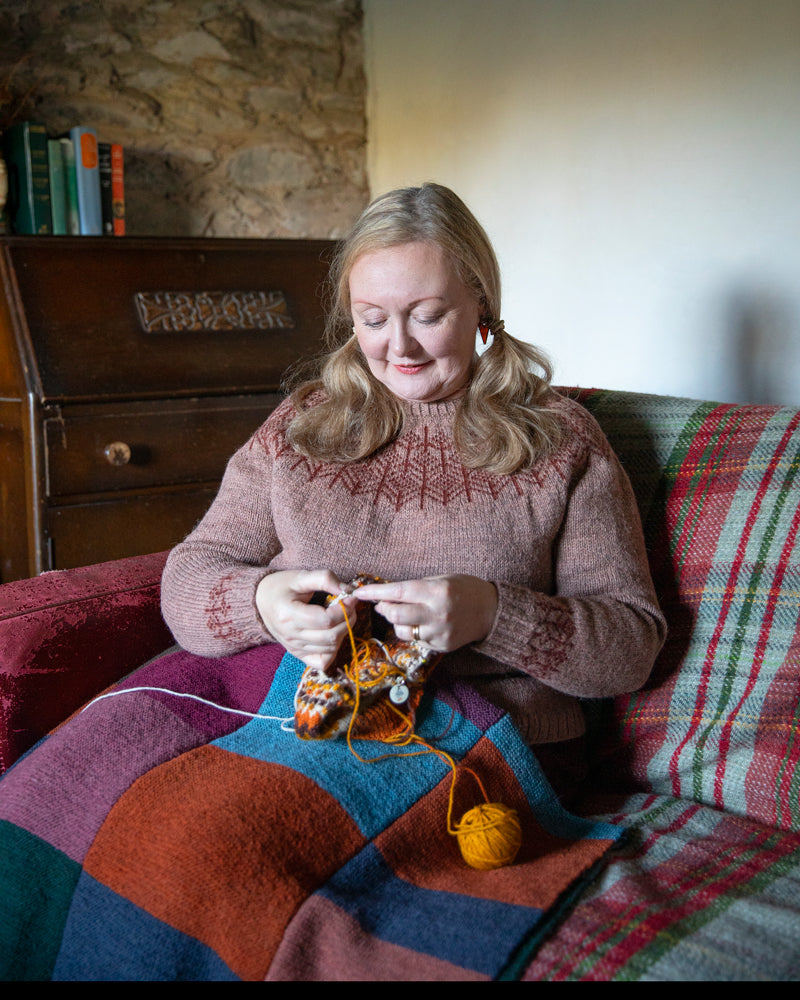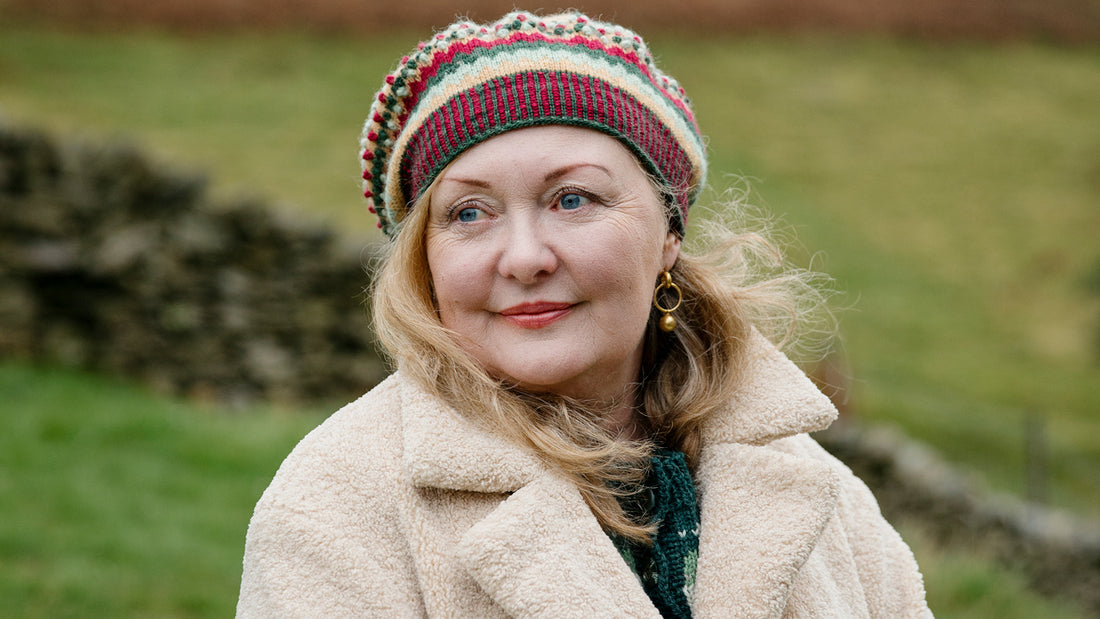Susan Crawford: Honouring History and Iconic Women
Susan Crawford is a British knitwear designer, fashion historian and author who is inspired by the stories carried within textiles and the intertwining of history and stitches. Susan has just released her eighth book Echoes: 24 Modern Knits Inspired by Iconic Women, featuring a variety of styles and techniques. Besides designing knitwear patterns and writing books, she has her own hand-dyed yarn range, using custom blends of British breed sheep.
We talked to Susan to learn more about her book, work and inspiration!

All of your book’s designs are inspired by iconic women who have influenced your life in some way, giving it a special personal touch. Why did you choose this approach?
I have always liked to work with themes and am often thinking of concepts which could serve as starting points for collections, and taking inspiration from women who have influenced me is an idea I have been pondering for some time. This particular collection began really with Virginia Woolf and a woven coat she was wearing, which inspired me to create both the Virginia and Dalloway patterns. That, in turn, caused me to think more about why I had turned to her for inspiration.
I have also recently lost my mother and my mother-in-law, both of whom were hugely important to me. I was thinking about their influence on me, and the idea for this book began to grow.

Tell us the story behind the name Echoes — what does it refer to?
At first, the name of the book eluded me. There was a word at the tip of my tongue that I just couldn’t find, that spoke of ideas rippling through time, of layers of inspiration intertwining, of threads of stories from the past coming together and of all these things moving forwards, inspiring ever more ideas. It became clear that the word that summed all this up, that explained the story behind the book in just six letters, was Echoes. The echoes of these inspirational women reverberating through my life and into my designs, hopefully inspiring other knitters and creating more echoes!

Do you have any personal favourites among the patterns?
Each design is personal and has so much meaning to me. But then there are designs which, once I wear them, I can’t bear to take them off! Dalloway, for instance: a wonderfully wearable and relaxed sweater with a beautiful colourwork yoke.
Vita is the cardigan I have always wanted to own — comfortable, stylish, effortless and beautiful. I also really love Parallel Lines, one of the two sock patterns in the book. They are basically the socks I want to wear every single day and have in every colour. And, of course, Gaskell. The perfect cabled cardigan with a cosy shawl collar and snuggly pockets. My grandmother had a cardigan similar to this one that she wore on an almost daily basis, and it’s always been my dream to create one of my own.

The book’s patterns feature a variety of techniques, such as colourwork, lace and cables. While some patterns require a certain skill level, others are suited for less-experienced knitters as well. Which patterns would you recommend to them?
I really wanted to create a range of patterns that would appeal to all knitters. For example, the Lauper neck tie and the Garnett vest/dress are great lace projects for beginners. Lauper is a super-quick project with small sections of lace at either end. Garnett brings lace into a garment pattern but retains the lace in straight panels surrounded by stocking stitch so the knitter can focus purely on knitting the lace pattern rather than shaping the garment.
There are several patterns which provide a great starting point for working colourwork. Agatha has a repeating colourwork motif on a simple fingerless mitten construction, and the Sayer sweater uses an easy slip-stitch pattern on a top-down yoke sweater – a great introduction to knitting a garment in this way.

All of the designs are knitted with your own range of hand-dyed yarns, under the name A Room Of My Own: a collaboration between yourself and your daughter, Charlie. Why did you start dyeing yarn?
I began hand-dyeing yarn regularly in 2018 as I wanted more variety of colour than I was able to obtain from commercial dye companies or from the palette in my existing yarn range. This had grown to 12 colours over the years, but there was still a very limited selection from which to create a design.
During the pandemic, my husband built a wooden shed perched on the side of a hill, which became the home to A Room of My Own dye studio, its name inspired once again by Virginia Woolf and her essay, A Room Of One’s Own. This additional space enabled us to bring the entire wool finishing process in-house. Charlie and I began to create a colour palette inspired by the rural and agricultural landscape surrounding us on our small hill farm, and as time passed, we gradually increased the range to include more and more colours. This has given me complete creative freedom when designing, to use any colour I want — which is particularly useful when recreating a colourwork garment! A design such as the Gertrude vest, which uses 11 shades, was created to explore the wide range of colours at my fingertips.

One important feature — almost like one of the main characters of the book — is the beautiful landscape shown in the photos. They were taken in the Lake District in North West England, where you live. Tell us a bit about this region and what you love about it!
I have lived in the North West of England for most of my life, but it is this far northerly corner that has my heart. Its rugged, wild landscape of fells and valleys surrounding its many lakes, the constantly changing weather conditions and the breathtaking beauty feed the soul. It comes as no surprise that so many artists, poets and writers have been inspired by the Cumbrian countryside.
At the same time, it is a working environment, with many small hill farms and local businesses plying their trade in its quaint villages and towns. This combination of nature and industry is particularly invigorating, and of course, there are the sheep! The landscape of the Lake District is one shaped by our woolly friends and the farms that care for them, and yet it is untamed and untameable. A place where the elements are in charge and allow us to share in its beauty.
“The loveliest spot that man hath ever found,” as William Wordsworth once said.

You are known for your work on modernising vintage knitwear patterns, and the past and present often interact in your work. What is it about the history of knitting that fascinates you?
It is often the stories within knitting that hold the most fascination for me. Knitting, and knitting patterns, are a door into the past; they tell you about culture, crafting practices, the role of women in society, social history, fashion history and so much more! You can tell if a 1940s pattern was printed during wartime or the immediate post-war period simply by whether the model is photographed inside or outdoors. You can find out about hairstyles in any decade by looking at the front cover of a pattern leaflet.
From a knitting point of view, it helps us understand the evolution of knitting language and how long some of the ‘modern’ techniques we use have actually been around. For example, I found instructions for an i-cord edging and top-down sleeves with short row shaping in a knitting pattern from the early 1920s. It really is incredibly fascinating what you can discover!

Echoes is your eighth book, and you have a long history as a designer and a knitter. Does the craft still manage to excite and inspire you?
It most definitely does. Knitting and designing are not just my job but are a part of what makes me who I am. Inspiration is all around us and I am constantly motivated and energised to create more designs and search for the connections within the stitches. Knitting and words are my creative outlets, so combining the two into books has always seemed to make perfect sense.

For me the books are part of that creative process rather than only a product. They are the equivalent of putting your work on display in a gallery, but the book is actually part of the exhibition. I love the process of deciding on a theme and turning it into a book, of holding that book in my hand and seeing the result of all those hours of effort.
I can’t imagine not knitting, designing, publishing — what on earth would I do?
Lean more:

